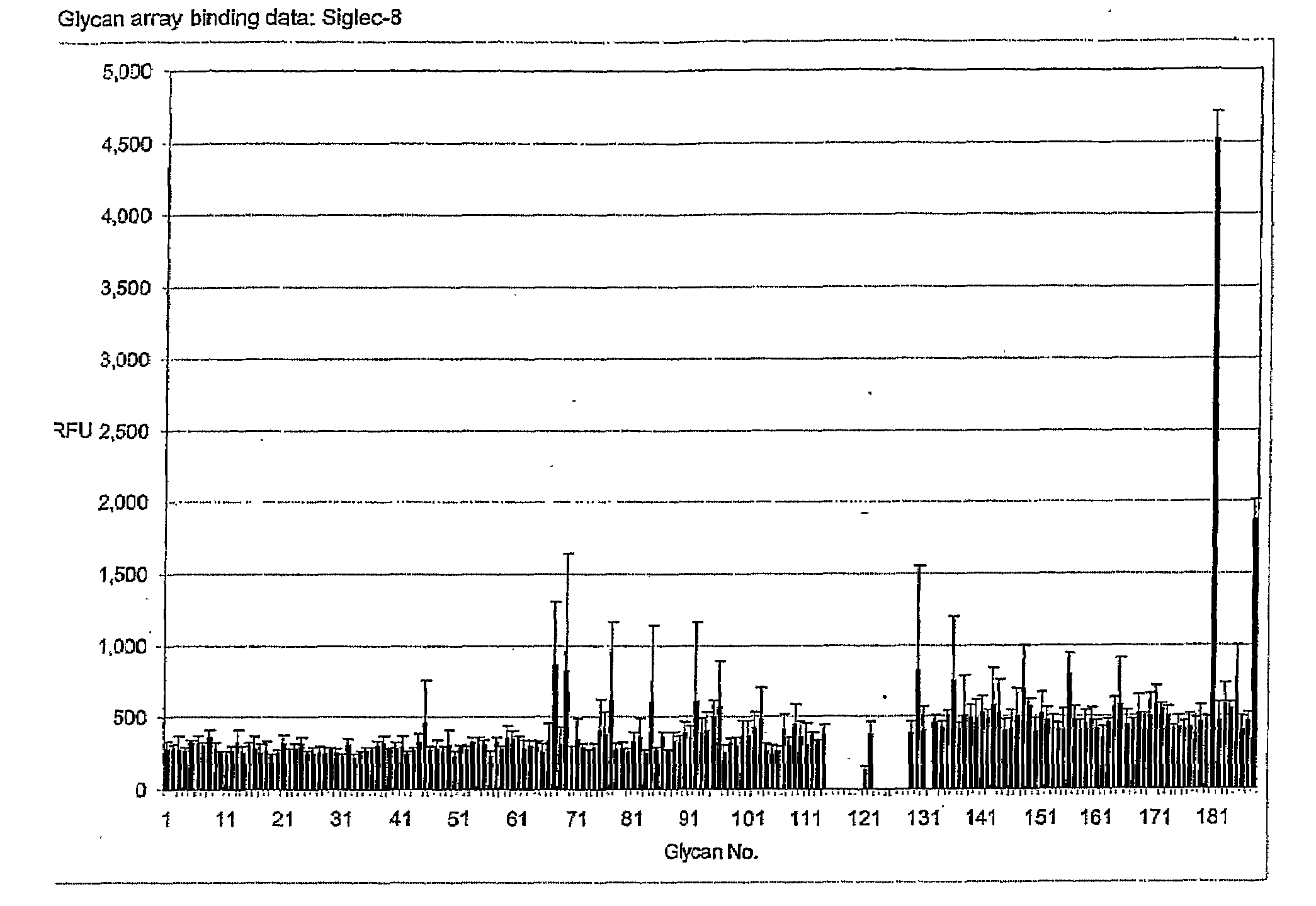Methods and Compositions For Treating Diseases and Disorders Associated With Siglec-8 Expressing Cells
a technology of siglec-8 and expressing cells, which is applied in the field of methods and compositions for treating diseases and disorders associated with siglec-8 expressing cells, can solve the problems of rather complex search for siglec ligands, and achieve the effects of reducing the activity and/or viability of these cells, reducing the number and/or level of activation, and alleviating symptoms
- Summary
- Abstract
- Description
- Claims
- Application Information
AI Technical Summary
Benefits of technology
Problems solved by technology
Method used
Image
Examples
example 1
Glycan Array Screening
[0089]Using the Glycan Array available through the Consortium for Functional Glycomics (http: / / www.functionalglycomics.org / static / consortium / resources / resourcecoreh.shtml), experiments were initiated to identify compounds that selectively and specifically bind to Siglec-8. Using Siglec-8-Ig fusion protein, a panel of 172 carbohydrate-based structures (see Table 1) was screened for specific Siglec-8 binding. As shown in FIG. 1, Siglec-8-Ig fusion protein had high affinity (12:1 signal-to-noise binding) for structure #181, also know as 6′-sulfo-sLex or NeuAcα2-3(6-O-sulfo)Galβ1-4(Fucα1-3)GlcNAcβ1-O(CH2)3NH—CO(CH2)5NH-Biotin (FIG. 2). Of additional particular relevance was that closely related structures to #181, such as structure #182, also known as 6-sulfo-sLex NeuAcα2-3 Galβ1-4(Fucα1-3)(6-O-Su)GlcNAcβ1-O(CH2)3NH—CO(CH2)5NH-Biotin, which only differs from structure #181 by the location of the 6-O-sulfate (FIG. 2), and structure #108, also known as sLex or NeuAcα...
example 2
Validation of Glycan Array Results by SPR
[0090]The binding affinities of Siglec-8 for #108, #182 and #181 (FIGS. 3 A-C, respectively) were determined on a Biacore B3000 instrument using a streptavidin-coated sensor chip. LacNAc glycoside was captured on one surface of the sensor chip and used as negative control (data not shown). As shown in FIG. 3, Siglec-8 showed specific binding, with very fast association and dissociation profiles only to the ligand #181. The sensorgrams show that upon injection of the Siglec, binding rapidly reaches equilibrium in the first few seconds and the bound Siglec falls off rapidly after the injection is stopped. The apparent Kd for binding of Siglec-8 to ligand #181, was between 2-2.5 μM (FIG. 4).
example 3
Further Verification of the Glycan Array Results
[0091]Binding of Siglec-8-Ig precomplexed with FITC-anti-human Fc to aminopropyl glycosides immobilized on activated (N-hydroxysuccinimidyl) glass surfaces was also used to further verify the specificity of 6′-sulfo-sLex as a Siglec-8 ligand. As shown in FIG. 5, fluorescent signals were detected at immobilized concentrations of 6′-sulfo-sLex as low as 5 pmol / spot. In contrast, sLex and 6-sulfo-sLex did not support any Siglec-8 binding at the highest concentration tested (300 pmol / spot).
[0092]Sialic acid binding immunoglobulin-like lectin 8 (Siglec-8) is selectively expressed on human eosinophils, basophils, and mast cells, where it regulates their function and survival. Previous studies demonstrated sialic acid-dependent binding of Siglec-8, but failed to reveal significant sub-structure specificity or high affinity of that binding. In an effort to test a broader range of potential ligands, a Siglec-8-Ig chimeric protein was tested for...
PUM
| Property | Measurement | Unit |
|---|---|---|
| pH | aaaaa | aaaaa |
| mol % | aaaaa | aaaaa |
| mol % | aaaaa | aaaaa |
Abstract
Description
Claims
Application Information
 Login to View More
Login to View More - R&D
- Intellectual Property
- Life Sciences
- Materials
- Tech Scout
- Unparalleled Data Quality
- Higher Quality Content
- 60% Fewer Hallucinations
Browse by: Latest US Patents, China's latest patents, Technical Efficacy Thesaurus, Application Domain, Technology Topic, Popular Technical Reports.
© 2025 PatSnap. All rights reserved.Legal|Privacy policy|Modern Slavery Act Transparency Statement|Sitemap|About US| Contact US: help@patsnap.com



